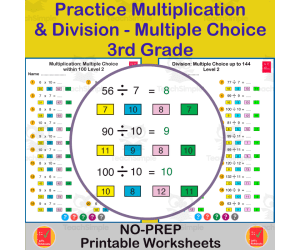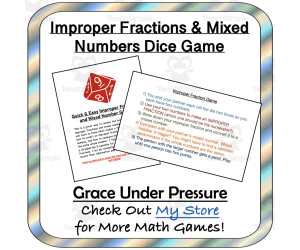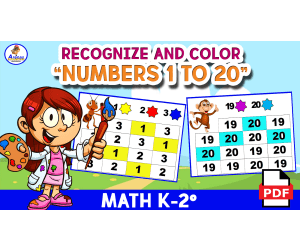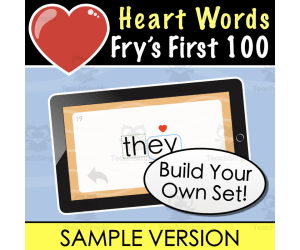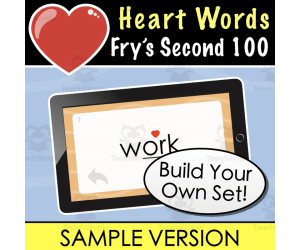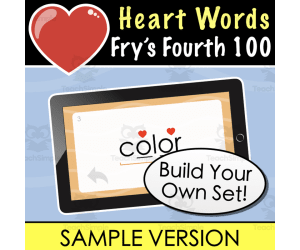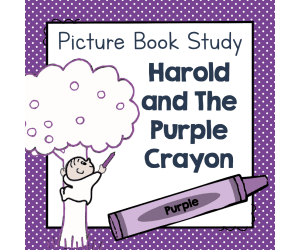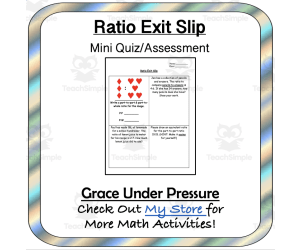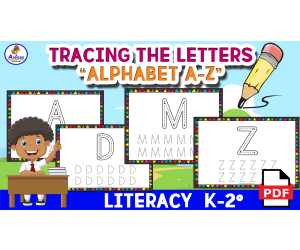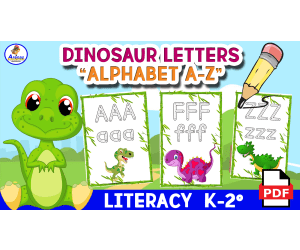2,776 products added recently
Page 527 - Newest Teaching Resources
Practicing Multiplication and Division - 3rd Grade - Multiple Choice
Math, Multiplication and Division, Multiplication, Division, Grade 3, Worksheets & Printables, Worksheets
Students in the third grade are at a critical juncture in their mathematical education. Mastering basic multiplication and division facts lays the foundation for future success in math and beyond. To meet this need, I have created another collection of printable worksheets to provide (almost) endless opportunities for practice. With a simple click, these worksheets can be generated on-demand with randomized numbers, ensuring endless variety. Students will never do the same sheet twice! Three difficulty levels allow you to differentiate for individual learners: - within 50 - within 100 - within 144 Additionally, the sets within the range of numbers to 100 & 144 each have a standard and advanced version. The standard version includes a mix of low and high numbers, while the advanced features predominantly larger numbers for an extra challenge. In total, there are three distinct worksheet types to target key skills: - 20 multiplication questions - 20 division questions - 20 mixed multiplication and division questions Each worksheet contains 20 questions in multiple choice format. Students select from four possible answers. This provides good practice for standardized testing formats. The benefits of these automatically generated worksheets are numerous. They allow students to practice key skills as often as needed to commit those facts to memory. You can use them for classwork, homework, review, assessment preparation, or daily practice throughout the year. Their endless variety means they never get dull or repetitive. These printables require no preparation on your part. Just print and use anytime. With answers automatically generated every time you create a new worksheet it makes them ideal for substitute teachers on short notice. Give your students the repetition they need to master multiplication and division. These no-frills worksheets will help them build a critical foundation for math success. Lastly, it's essential to note that these resources are compatible PDF documents. They operate seamlessly with the official Adobe Acrobat Reader on both Windows and Mac.
Author Jeff's Notebooks
Tags Math, Multiplication, Division, Practice, Fluency, 3rd Grade, Worksheets, Unlimited, JeffsNotebooks, Within 100
letter z handwriting worksheet - letter z activity for kindergarten
ELA, Language Development, Pre-Reading, Writing, Creative Writing, Handwriting, Not Grade Specific, Activities
This package contains activities to help children learn the letters of the alphabet. This package contains different educational activities to help teach children to write the letter Z. This package contains 12 different and fun activities to teach children to write the letter Z. What are the appropriate ages for this package? This package is suitable for the early years and first grades. It contains various basic activities that help children learn to write letters in a healthy way and sense letters through various activities. These ages are for the early years and first grades. It contains various basic activities that help children learn to write letters in a healthy way and sense letters through various activities. How can you use these worksheets? Worksheets can be used to enhance students' abilities to learn to write letters in a healthy and fun way. The teacher can present these worksheets as one of the daily activities in class, and they can also be presented as homework. It can be used in accordance with the educational curriculum or teaching style followed by the teacher. What do these worksheets contain? Letters tracing Writing letters Connect the letters Color letter Z, z. And trace it Coloring letter Z (capital) Coloring letter z (small) Find and color letter Z Find and circle letter Z Letter mazes Z is for... Choosing the words Writing words Information on this digital file: File format: pdf file. Number of pages: 12 different pages. Suitable age: Kindergarten, first grade, or homeschooling. (you can use it for any Suitable age) type of this resource: all about letter Z. You can visit my profile and view a variety of worksheets and educational activities. If you like these worksheets and want more similar educational activities, you can visit my profile and choose educational worksheets and activities suitable for children.
Author successful teachers resource
Tags Letter Z Activity Worksheet, Handwriting Practice Letter Z, Letter Z Worksheets For Kindergarten, Letter Z Worksheets For Preschool, Letter Z Handwriting Practice, Letter Z Writing Page, Tracing Letter Z Printable, Letter Z Tracing Worksheets Preschool, Letter Z Tracing Worksheets For Preschool
Improper Fractions and Mixed Numbers Dice Game
Math, Fractions, Grade 3, 4, 5, 6, 7, Activities, Games
This is a fun and easy game to add to your fractions unit to help students practice working with mixed numbers and improper fractions. Students must demonstrate knowledge of what makes an improper fraction, how to convert an improper fraction into a mixed number, and how to order and compare mixed numbers. I suggest using 10-sided dice (if possible) for a wider variety of outcomes. I encourage my students to use mini-whiteboards for recording their work and doing their calculations. Student Instructions: 1) You and your partner each roll the die two times so you each have two numbers. 2) Use your two numbers to make an IMPROPER FRACTION (which one should be the numerator?). 3) Write down your improper fraction and convert it to a mixed number. 4) Compare with your partner’s mixed number. Which number is bigger? You might have to find a common denominator if the whole numbers are the same. 5) The person with the larger number gets a point. Play until one person has five points. Grades to Use With: This is a simple game that can be an addition to a lesson or fraction review in grades 3-7 when students are working with fractions that have a value greater than one. Standards: CCSS3NF.A.3 Compare fractions by creating equivalent fractions CCSS4NF.A.2 Compare fractions by creating equivalent fractions- finding common denominators CCSS4NF.B.4a Fractions greater than 1 and multiplying fractions What's Included: A simple 2 Page PDF. One instruction page for teachers and one half-page instruction sheet for students (cut one page in half and give to two groups). Check out other fun math games in my store: Lucky Leprechauns: St. Patrick's Day Math Game: Multiplication Whole Class Jackpot Game Decimal Place Value Game: Tenths to Millionths Perimeter of Complex Shapes: Math Strategy Game Grocery Game: Estimating, Adding and Multiplying Decimals
Author Grace Under Pressure
Tags Fractions, Improper Fractions, Mixed Numbers, Comparing Fractions, Dice Game, Math Game, Math, Coverting Fractions, Grade 4 Math, Fraction Dice Games
Human Rights: Access to Water (Canada) An Integrated Math and Social Studies Lesson
P.E. & Health, Social Studies, Health, Math, Percentages, First Peoples (Native), History, History: Canada, Grade 5, 6, 7, 8, Worksheets & Printables, Word Problems, Worksheets
Human Rights: Access to Water (Canada) - An Integrated Math and Social Studies Lesson This teaching resource is designed for middle grades students (5th-8th grades). It combines the subjects of math and social studies into one integrated lesson about water, human rights, and the kind of world we want to live in. The main focus: This lesson raises the question why all residents in Canada, especially in First Nations communities, don't have access to clean and drinkable water. While providing a basic understanding of human rights, it specifically examines water as a fundamental right. Tasks Involved Include: Defining human rights in their own words Looking at the UN Declaration of Human Rights and putting some rights into their own words Thinking about why clean water is a human right A case study on current water quality advisories in British Columbia (link provided) Determination of part-to-part & part-to-whole ratios and percentages using live data Reflecting on the fairness of the current situation Calculation of personal daily water usage Determining how long it would take to boil one's required amount of water pot by pot These tasks demonstrate the practical impact that math has on everyday life while shedding light on unfair access to clean drinking water. They require students to use critical thinking and applied math skills to tackle an important social issue. Grades to Use With: This lesson is designed for students in the middle grades (5-8) and can be used in math class when studying ratios and proportional relationships OR social studies class when studying indigenous issues and human rights. What's Included: 4 Page PDF: Title Page Brief Overview of Human Rights and Water as a Specific Human Right Case Study of Water Advisories in British Columbia, Canada Math Application: How long would it take to boil all the water you use each day?
Author Grace Under Pressure
Tags Human Rights, Access To Water, Canada, Math And Social Studies, Clean Water, Indigenous, Indigenous Rights, First Nations, Ratios, Percentages
Differentiated Close Reading Comprehension for 3rd-4th Grade: Iditarod
ELA, Reading, Reading Comprehension, Grade 3, 4, 5, Worksheets & Printables, Worksheets
Differentiated Close Reading Comprehension for 3rd and 4th Grade: "What is the Iditarod?" Informational Text Worksheets Package Motivate your students by adding this differentiated reading package on a highly engaging topic to your collection of non-fiction close reading comprehension materials. As March rolls around, print and distribute these ready to print materials to introduce your class to the topic of the famous annual Alaskan dogsled race and answer the question, "What is the Iditarod?" To help you reach all of your students with differentiated learning materials, there are two versions of the basic informational text included, a harder version and an easier. The two differentiated reading passages are followed by the same set of multiple choice questions to test close reading comprehension. An answer key is provided to make checking or self-checking easy and quick. Part of the answer key is a copy of the marked up passage, with text supporting the answers highlighted and underlined. These no prep, print and go worksheets are perfect for literacy centers , seatwork and homework. Use them to supplement your other Iditarod and informational text materials, or to introduce a fun new topic to your collecction of reading resources. The worksheets are in a black and white format which make them suitable for low cost printing and distribution Make it easy for everyone in your class, even the weaker readers, to learn more about this exciting event that appeals to so many students. Format and Content: The 15-page PDF includes the basic informational text passage in both black and white and full color versions, an easier to read passage also in black and white and color, a single-page worksheet of close reading questions, an answer key and a copy of the passage with text supporting the answers identified.. The primary curriculum standard addressed is CCSS.ELA-LITERACY.RI.4.1: Refer to details and examples in a text when explaining what the text says explicitly and when drawing inferences from the text.
Author WorksheetsPlus
Tags Differentiated Learning, Reading Comprehension, English, Reading, Close Reading, Leveled Reading, Iditarod, Differentiated Reading, Dogsled
Country Study on Latvia - Geography Teaching Resource - Europe
Social Studies, Geography, History, History: Europe, Grade 7, 8, 9, 10, 11, 12, Teacher Tools, Presentations
Country Study on Latvia - Geography Teaching Resource - Europe This Teaching Resource is an Introductory PDF Presentation (14 Slides) on Latvia. This Digital Resource can be great for Geography, European History and Social Studies Classes. Suitable Learners for this kind of lesson are students from 7th Grade to 12th Grade. This Geography + Social Studies Presentation on Latvia (European Country Study) aims to introduce learners to Latvia (its most important and basic facts, languages, history, environment, economy and basic Latvian vocabulary). No or little preparation is needed. Within this Introductory Presentation on Latvia (PDF Europe Country Study Teaching Resource) it is offered: a first slide with greetings in Latvian Language (Sveiki) with QR Codes and link to YouTube Video to learn how to pronounce it properly in Latvian language 2 slides on Latvia + its basic geography (Google Maps Link directed to Latvia's geographical location included) a "quick data on Latvia" slide (currency, population, kind of government etc) 2 slides on the Language spoken in Latvia (one as an introduction to Latvian and minority languages such as Russian and Livonian + a second one with basic Latvian Language Vocabulary) 1 slides with Latvia's History timeline (from the first Uralic and Baltic tribes to the NATO membership) 1 Slide on Geographical facts (size, kind of territory and weather) 1 on Latvia's Economy 1 on Riga 1 on other cities in Latvia (little map of Latvia with cities such as Jelgava and Liepaja) 1 slides on Latvian Culture 1 last slide with Goodbye written in Latvian (Uz redzēšanos) This Social Studies + Geography Country Study on Latvia PDF Digital Teaching Resource (14 slides) can be great for learners from 7th grade to 12th grade to introduce Latvia and its Culture. Learning with Alan is a Brand New Teaching Resource/Educational Material Store whose aim is to help Teachers, Educators and Tutors to achieve their teaching objectives while creating a fun and stimulating environment. Never Forget! If you want to browse more of my Teaching Resources, click here Learning with Alan!
Author Learning with Alan
Tags Country Study, Geography, Social Studies, Timelines, Teaching Resource, Europe, Latvia, European History, European, Presentation
ADDITION UP TO 20 - 10 pages of exercises
Math, Addition and Subtraction, Addition, Kindergarten, Preschool, Grade 1, 2, Activities
1. Brief introduction: Performing mathematical operations is important for children, especially when it comes to learning to add, because it is a basic activity in daily life. For this reason, today we have prepared this educational worksheet so that students can practice addition in a didactic way, with numbers from 1 to 10, with results that are less than 20. I hope that this worksheet is very useful for you. . 2. Title of the pedagogical resource: "Additions with results up to 20" 3. Topic to work on: Additions of numbers from 1 to 10. 4. Area of knowledge where it should be applied: This educational sheet could be applied in the area of teaching mathematics. 5. Number of pages contained: This document contains 10 pages, ready to be printed. 6. Is it available in color or white/black? This pedagogical resource is available in colors so that it is much more attractive to students. 7. What version is it available in? This educational sheet is available in PDF version, ready to be printed. 8. Editable/Not Editable: This document is not editable. 9. Age at which it can be applied: This resource could be used in children who have already passed the concrete phase of learning addition, and have already moved on to the abstract phase, and are capable of making additions that give results up to 20. 10. Tags or keywords that describe the content: additions up to 10, additions up to 20, addition exercises, addition exercises for children, additions for children, addition worksheets for children. 11. Ways to print: I recommend that you print this sheet in color, so that it is much more fun for the students. I also suggest that you print it in the size you find or perhaps you can reduce 2 pages into 1 and thus save paper. I always ask you to certify that the numbers are visible to the children, and that they have enough space to place the answers. 12. Forms of application in class: I recommend that you apply this sheet individually. so that learning is more personalized.
Author EDITORIAL LAURA EDUCA
Tags Addition To 10, Addition To 20, Addition Up To 20, Addition Up To 10
RECOGNIZE AND PAINT - Numbers 1 to 20
Math, Numbers, Kindergarten, Preschool, Grade 1, 2, Activities
1. Product name: "Recognize the numbers from 1 to 20 and paint the corresponding box" 2. Page number: This document contains 8 pages ready to be printed. 3. Is it editable or not? This educational resource is not editable, since it is ready to be printed. 4. Theme: The topic to be developed in these educational worksheets is the numbers from 1 to 20. 5. Document version: This document is in PDF version. 6. Color or white/black: This educational resource is developed in colors so that it is much more fun and attractive for students. 7. Aimed at children of ages: It is aimed at children aged 4,5,6,7 who are learning the first numbers from 1 to 20. 8. Area: This document is suggested to be applied in the area of teaching mathematics for children. 9. Keywords: mathematics, mathematics worksheets , numbers from 1 to 20, numbers from 1 to 10, recognizing numbers. 10. How do I print it? We suggest you print this in a colored version, and in the size you find, so that the numbers are recognizable to children. Otherwise, you could also apply a 2-sided reduction on 1 sheet at most. 11. How to apply it in class? I suggest you apply these worksheets individually so that your student's learning is much more personalized. 12. Will you need extra elements to use this sheet? Yes, the children will need colors, markers or any element that you paint and that the children like to use, so that the activity is much more interesting for them. 13. Standards: This document was not prepared based on any specific standard. 14: Answer key: This document does not contain an answer key. 15. Variations in its application: You can apply this resource as practice in class or send it as homework to your students' homes.
Author EDITORIAL LAURA EDUCA
Tags Numbers, Numbers 1 To 20, Numbers 1 To 10, Painting Numbers
Climate Change Handout: Simple Explanation with Visuals
Science, Technology, Earth and Environmental Sciences, Earth Sciences, Environmental Science, Grade 4, 5, 6, 7, 8, 9, 10,
Climate Change Handout: Simple Explanation with Visuals This student-friendly product offers a simplified scientific explanation of climate change. Tailored for learners in grades 4-10 or high school special education classes, it is designed as a one-page handout - a tool educators can easily print and distribute to add to their unit on climate change/global warming. The handout simplifies complex terms using clear visuals and reader-friendly language. Concepts introduced include greenhouse gases and their sources, and thermal energy's role in global warming events triggered by human activities. The impact of actions such as burning fossil fuels or deforestation is explained and the resultant emissions measured in CO2e (carbon dioxide equivalents) are introduced. This resource naturally complements other climate change activities in my store: projects like Personal Carbon Emissions Calculation Project (CLICK HERE) or Climate Change Solutions Project (CLICK HERE) . It can be presented for the whole class on an interactive whiteboard to stimulate classroom discussions, or it can be used in small group sessions where each student has their own individual handout. Main features: Simplified language and clear visuals to explain complex scientific concepts An evidence-based approach to highlight human impact on climate change A flexible teaching aid suitable for various learning settings & styles Compliance with NGSSMS-ESS3-5 standard documentation What's Included: A simple, one page handout in PDF form. Ready to print and go! Grades to Use With: This handout is perfect for students from grades 4-10. It could also be used in high school special education classrooms. If you want other science activities, check out these in my store: 8 Low-Prep STEM Tasks for Elementary and Middle School : with simple handouts for each experiment Science Project: Creative Creatures: Biomes, Structural and Behavioural Adaptations Paper Helicopter STEM Project: Grade 5-7 Scientific Method Mini Unit Correlation Does Not Equal Causation : Scientific Method and Critical Thinking Lesson
Author Grace Under Pressure
Tags Climate Change, Science Education, Global Warming, Greenhouse Gases, Environmental Awareness, Climate, Environment, Earth Science, Science, Elementary Science
SAMPLE Heart Words | Fry’s First 100 | Build Your Own Flash Cards Set
ELA, Language Development, ESL, Phonics, Vocabulary, Kindergarten, Preschool, Grade 1, Worksheets & Printables, Flashcards
These digital flash cards don't just show Fry's First 100 Sight Words. They also display so-called "Heart Words". These are words that don't use the phonics rules that one might expect when reading and trying to pronounce the word. But this is not all. Also blends, digraphs, trigraphs, double consonants and many more phonetic elements are separately highlighted in each component of this resource. Please Note: This is a Sample Version. Two selections of 20 words are featured in this product. Please check out the FULL version to get flash cards of every single one of Fry's First 100 Sight Words. There are several parts to this resource. Please check out the screenshots on this page to get a better idea of the aesthetics of this resource. The included components are: 1. Digital Flash Cards (Digital PDF) This activity is offered in a PDf-Format. Simply use the arrow keys to navigate through the slides. 2. Build Your Own Set (PowerPoint) This activity comes in a PowerPoint format. This allows you to pick and choose the cards that you like to create your very own set. Just copy and paste the slides in whichever order you prefer. 3. Printable Flash Cards (Printable PDF) The same card that are featured in the previous activity also come in a printable format. Again, this is a PDF-File. Just print, laminate, and cut the cards, and you'll be ready to go! 4. Vocabulary List 1 (Printable PDF) This list shows all of Fry's First 100 Sight Words in alphabetical order. The words are color coded so you can see from which set it originates. 5. Vocabulary List 2 (Printable PDF) This list shows all of Fry's First 100 Sight Words in order of frequency. All the words are divided in 5 groups of 20 words. They have the same color code as the ones in the previously discussed list. If you have any comments, suggestions, or questions, feel free to contact me at toms.talk.resources@gmail.com Wishing you lots of fun with this resource!
Author Tom's Talk
Tags ESL, PDF, ELA, Fry's, Fry, Sight Words, Fry's Sight Words, Flash Cards, Flashcards, Digital
SAMPLE Heart Words | Fry’s Second 100 | Build Your Own Flash Cards Set
ELA, Language Development, ESL, Phonics, Vocabulary, Kindergarten, Preschool, Grade 1, Worksheets & Printables, Flashcards
These digital flash cards don't just show Fry's Second 100 Sight Words. They also display so-called "Heart Words". These are words that don't use the phonics rules that one might expect when reading and trying to pronounce the word. But this is not all. Also blends, digraphs, trigraphs, double consonants and many more phonetic elements are separately highlighted in each component of this resource. Please Note: This is a Sample Version. Two selections of 20 words are featured in this product. Please check out the FULL version to get flash cards of every single one of Fry's Second 100 Sight Words. There are several parts to this resource. Please check out the screenshots on this page to get a better idea of the aesthetics of this resource. The included components are: 1. Digital Flash Cards (Digital PDF) This activity is offered in a PDf-Format. Simply use the arrow keys to navigate through the slides. 2. Build Your Own Set (PowerPoint) This activity comes in a PowerPoint format. This allows you to pick and choose the cards that you like to create your very own set. Just copy and paste the slides in whichever order you prefer. 3. Printable Flash Cards (Printable PDF) The same card that are featured in the previous activity also come in a printable format. Again, this is a PDF-File. Just print, laminate, and cut the cards, and you'll be ready to go! 4. Vocabulary List 1 (Printable PDF) This list shows all of Fry's Second 100 Sight Words in alphabetical order. The words are color coded so you can see from which set it originates. 5. Vocabulary List 2 (Printable PDF) This list shows all of Fry's Second 100 Sight Words in order of frequency. All the words are divided in 5 groups of 20 words. They have the same color code as the ones in the previously discussed list. If you have any comments, suggestions, or questions, feel free to contact me at toms.talk.resources@gmail.com Wishing you lots of fun with this resource!
Author Tom's Talk
Tags ESL, PDF, ELA, Fry's, Fry, Sight Words, Fry's Sight Words, Flash Cards, Flashcards, Digital
SAMPLE Heart Words | Fry’s Fourth 100 | Build Your Own Flash Cards Set
ELA, Language Development, ESL, Phonics, Vocabulary, Kindergarten, Preschool, Grade 1, Worksheets & Printables, Flashcards
These digital flash cards don't just show Fry's Fourth 100 Sight Words. They also display so-called "Heart Words". These are words that don't use the phonics rules that one might expect when reading and trying to pronounce the word. But this is not all. Also blends, digraphs, trigraphs, double consonants and many more phonetic elements are separately highlighted in each component of this resource. Please Note: This is a Sample Version. Two selections of 20 words are featured in this product. Please check out the FULL version to get flash cards of every single one of Fry's Fourth 100 Sight Words. There are several parts to this resource. Please check out the screenshots on this page to get a better idea of the aesthetics of this resource. The included components are: 1. Digital Flash Cards (Digital PDF) This activity is offered in a PDf-Format. Simply use the arrow keys to navigate through the slides. 2. Build Your Own Set (PowerPoint) This activity comes in a PowerPoint format. This allows you to pick and choose the cards that you like to create your very own set. Just copy and paste the slides in whichever order you prefer. 3. Printable Flash Cards (Printable PDF) The same card that are featured in the previous activity also come in a printable format. Again, this is a PDF-File. Just print, laminate, and cut the cards, and you'll be ready to go! 4. Vocabulary List 1 (Printable PDF) This list shows all of Fry's Fourth 100 Sight Words in alphabetical order. The words are color coded so you can see from which set it originates. 5. Vocabulary List 2 (Printable PDF) This list shows all of Fry's Fourth 100 Sight Words in order of frequency. All the words are divided in 5 groups of 20 words. They have the same color code as the ones in the previously discussed list. If you have any comments, suggestions, or questions, feel free to contact me at toms.talk.resources@gmail.com Wishing you lots of fun with this resource!
Author Tom's Talk
Tags ESL, PDF, ELA, Fry's, Fry, Sight Words, Fry's Sight Words, Flash Cards, Flashcards, Digital
"Ten Apples Up On Top" | Picture Book Study
ELA, Reading, Preschool, Grade 1, Worksheets & Printables, Novel Studies
Bring the fun counting story of Ten Apples Up On Top to life with this comprehensive picture book study . Over 40 activities tailored for early learners included! Students will love piecing together puzzles and mazes, sequencing events, practicing early literacy skills, and exploring STEM concepts. Extension projects allow learners to build fine motor control stacking playdough apples, illustrate imaginative new versions of the story, and write creative ideas for balancing apples. The worksheets, crafts, videos and printables encourage math, reading and critical thinking skills. Tracing letters, matching vocabulary images, and completing partial sight words allow emerging readers to master foundational literacy abilities. Sequencing strips, story elements activities, and compare/contrast sheets build narrative comprehension and logical reasoning. The apple theme engages students while strengthening counting concepts, one-to-one correspondence and shape recognition. Sorting tasks require analyzing attributes like color, size and quantity. Open-ended drawing and writing prompts nurture artistic expression and early writing skills. Differentiated materials provide the just-right level of support and challenge for individuals. Teachers can easily tailor activities to needs. This picture book study encourages a love of reading for each student in your class. Students will look forward to their reading activities each day while you are working through this unit!
Author Simply Schoolgirl
Tags Ten Apples Up On Top, Ten Apples Up On Top Printables, 10 Apples Up On Top Pdf, Ten Apples Up On Top Pdf, 10 Apples Up On Top Coloring Page, Ten Apples On Top Activities, Apples Up On Top Activities, Ten Apples Up On Top Activities Preschool, 10 Apples Up On Top Activities, Ten Apples Up On Top Activity
"Goodnight Moon" | Picture Book Study
ELA, Reading, Kindergarten, Preschool, Grade 1, Novel Studies, Worksheets & Printables
Revisit the classic story Goodnight Moon again and again with this comprehensive picture book study . Over 40 thoughtful activities extend student engagement with this comforting bedtime tale that has been passed down across generations. Puzzle pieces offer an opportunity for hands-on learning. Sequencing strips challenge emerging readers to place key events in order. Writing prompts encourage young writers to envision their own cozy bedrooms. Tracing the moon’s phases helps with the development of fine motor skills while letter formation pages introduce foundational literacy skills. Compare characters and settings to other tales with Venn diagrams. Analyze story elements like setting and conflict through interactive worksheets. Draw the cow jumping over the moon and match rhyming vocabulary couplets. The included videos, coloring sheets, and hands-on games introduce new vocabulary to build listening skills. Differentiate to meet individual needs by choosing appropriate activities for each learner. Challenge early finishers to design an alternate cover or add a new verse. Provide additional tracing assistance to others. With over 40 cross-curricular printables spanning unrestrained creativity to structured literacy practice, this adaptable resource leverages a cherished bedtime tale to foster personalized achievement. Students gain confidence in emerging abilities while revisiting the comforting rituals of story time before drifting off to sleep.
Author Simply Schoolgirl
Tags Goodnight Moon, Sound Cards, Sequencing Strips, Literacy Center, Jigsaw Puzzles, Handwriting Practice, Coloring Pages, Goodnight Moon Activities, Goodnight Moon In Hebrew
"Harold and the Purple Crayon" | Picture Book Study
ELA, Reading, Kindergarten, Preschool, Grade 1, Novel Studies, Worksheets & Printables
This fun picture book study features "Harold and the Purple Crayon". This is a classic story that students will love reading over and over again! This resource is packed with 40 activities for your preschoolers, kindergarteners, and first graders. Students will light up when they see the puzzle pieces reveal scenes from Harold's journey. They will practice sequencing plot points and drawing their own magical adventures sparked by the story prompts. As they color, trace letters, and learn new vocabulary, the activity pages build fine motor control and reading skills. Emerging readers gain confidence matching sight words, sounding out sentences, and communicating ideas. Creativity springs from every page - like comparing crayon making to Harold's imaginary world while designing original living spaces and stories. Open-ended questions allow awesome conversations about the tale and their own perspectives. The range of activities exposes students to literacy, critical thinking, and self-expression in a fresh way. New vocabulary fosters listening skills to support comprehension. The teacher tips facilitate enriching discussions where kids feel comfortable sharing observations, opinions and questions. Harold's magical journey motivates skill-building blended seamlessly with creativity. Students will love illustrating their dream bedrooms, thinking of purple crayon fantasies, and crafting their own plots while naturally advancing letters and storytelling abilities.
Author Simply Schoolgirl
Tags Picture Book Study, Harold And The Purple Crayon, Nonfiction Article, Comparing Stories, Book Reports, Color Words, Writing Pennants, Crayon Picture Book, Harold And The Purple Crown, Harold And The Purple Crayon Crafts
"Imogene's Antlers" | Picture Book Study
ELA, Reading, Kindergarten, Preschool, Grade 1, Novel Studies, Worksheets & Printables
This imaginative and playful picture book study brings the charming story of Imogene and her extraordinary antlers to life. With over 40 engaging activities, this resource sparks creativity, critical thinking, and fun. Students will love piecing together puzzles and mazes, designing hats and book covers, practicing early reading skills, comparing plots, and exploring the themes of individuality and self-expression. Extension projects let young learners add themselves into photos as Imogene, write from new perspectives, and envision additional antler adventures. With diverse printables, videos, discussion topics, and writing prompts tailored for preschool to early elementary, this study transforms a delightful tale into impactful learning across the curriculum. Students will be captivated by Imogene’s journey while building foundational literacy skills. Activities like tracing letters, matching words and pictures, and completing partial words allow emerging readers to practice phonemic awareness, letter formation, and sight word recognition. Sequencing strips, story elements worksheets, and compare/contrast activities reinforce narrative components and comprehension. Open-ended drawing, writing templates and imaginative prompts nurture self-expression and storytelling abilities. This magical resource makes reading meaningful. As students explore this whimsical story, they will also expand early math concepts, fine motor skills, and creative thinking. Coloring pages, cut-and-paste activities, dot-to-dots, and puzzles strengthen fine motor control while exposing learners to patterns, shapes and spatial navigation concepts. Inventive extensions invite students to envision plot possibilities, empathize with characters, and appreciate multiple perspectives. With cross-curricular connections and developmental adaptability, this picture book unit leverages the charm of Imogene's antlers into impactful early childhood learning.
Author Simply Schoolgirl
Tags Imogene's Antlers, Picture Book Study, Missing Story Words, Digraphs Worksheet, Sequencing Strips, Vocabulary, Sight Words, Handwriting, Tracing, Imogene's Antlers
ESL Lesson Plan on Space Exploration and Travelling
ELA, Writing, Language Development, Vocabulary, Reading, Reading Comprehension, ESL, Grade 7, 8, 9, 10, 11, 12, Teacher Tools, Lesson Plans
ESL Lesson Plan on Space Exploration and Travelling This ESL EFL Lesson Plan on Space Exploration and Travelling (PDF Digital Lesson 14 slides + answer key) can be Great to help stimulate English Learning within Newcomers or any English as a Second Language Student. Ideal participants for this Activity are Foreign Languages Students at Middle School and early High School (teens). This Product can also be Great for ESL Centers Abroad and ESL Tutors or private teachers. This ESL EFL TESOL TEFL Lesson Plan on Space Exploration and Travel can be more than great for intermediate, advanced English as a Second or Foreign Language Students. This Stimulating ESL EFL Lesson Plan on Space Exploration (14 slides + Answer Keys in the last slide) includes: 1 Introduction to Space Exploration 1 Warm-Up Picture Description ESL EFL TESOL Activity given of 5 scenes (Nicolaus Copernicus looking up into the sky, painting by Jan Matejko + a scene of "Trip to the moon" by Georges Méliès + Moonlanding + Astronauts Training in a swimming pool in Houston, Texas + future moon colony) 1 Listening comprehension Activity (with answers keys in the last slide) with QR Code-Linked YouTube Video 1 Writing Activity with 2 Essay Prompts (writing about ideas the next step in space exploration + telling if you want to become an astronaut) This ESL, EFL, TESOL, TEFL PDF Digital Teaching Resource Lesson Plan on Space Exploration and Travelling (14 slides + answer keys in the last slide) can be great for Intermediate Advanced English as a second or foreign language learners. Its aim is to make students exercise and improve their Listening comprehesion and Writing English as a second language Skills. Learning with Alan is a Brand New Teaching Resources Store whose aim is to help English as a Second or foreign Language Teachers, Educators and Tutors (be it online or offline) to achieve their teaching objectives while creating a fun and stimulating environment. Never Forget! Learning is fun, So should English! Always If you want to browse more of my PDF ESL, EFL, TESOL Teaching Resources, click here Learning with Alan!
Author Learning with Alan
Tags ESL, English, Lesson Plan, Teaching Resource, Space, Exploration, Listening, Writing, Essay, Comprehension
Ratio Mini Quiz/Exit Slip
Math, Fractions, Grade 5, 6, 7, Quizzes, Quizzes and Tests, Teacher Tools
Here is a quick and easy assessment , exit slip, or mini quiz for your ratio and proportional relationships math unit in the middle grades (5-7). Simply print one copy for each student and use it midway through your unit to check in on your students' understanding. You can gather valuable information about which students are struggling (if they have trouble with most of the questions) and which areas of instruction need more review (if many students get one specific problem incorrect). 1) First, students have to write both a part-to-part and part-to-whole ratio for a simple picture. 2) Next, they use a ratio to calculate how many items a student has in a collection. 3) There is a question about making lemonade using a ratio in the recipe. 4) The final question asks students to make and draw an equivalent ratio. To make it easier for themselves they should use division instead of multiplication. Who will notice? Grades to Use With: This assessment is designed for students in grade 6 who are learning about ratios and proportional relationships. It could be used in grade 5 for enrichment or grade 7 for review. It could also. be used in high school special education classrooms. What's Included: A ready-to-print 1 page PDF that is a perfect mid-unit assessment . If you enjoy this grade six math activity, check out others in my store: 6th Grade Math: Geometry Bundle: 5 Activities: Area, Perimeter, and Volume 6th Grade Math: Number System Bundle: 8 Activities: Integers, Decimals 6th Grade Math: Ratio and Proportional Relationships Bundle: 6 Activities 6th Grade Math: Expressions and Equations Bundle: 7 Activities 6th Grade Math: Statistics and Probability Bundle: 4 Activities Transformation Design with Rubric Math Mini Unit: Converting Scores into Percentages Math Project: Create Your Dream Store Geometry Project: Park Design with Area, Perimeter, Volume and Budgeting
Author Grace Under Pressure
Tags Ratios, Part-to-part Ratios, Part-to-whole Ratios, Exit Slip, Math Quiz, Grade 6 Math, 6th Grade Math, Ratio Quiz, Ratio Exit Slip, Word Problems
Reading Comprehension Passage: Algorithms: Integrated Math & Computers
ELA, Reading, Reading Comprehension, Writing, Math, Percentages, Grade 8, 9, 10, 11, 12, Worksheets & Printables, Worksheets
Are you trying to get your high school students interested in math, computer science, and current events while practicing reading comprehension and vocabulary? Why not give them a crash course on the concept of algorithms. It's a word that we use in our daily conversation, but do you know what they really are? This comprehensive lesson includes: Five parts in an easy to use 8 page PDF: First, students will tackle a 2-page reading comprehension passage about algorithms. This passage teaches about the basic concepts surrounding computer algorithms: the types, what they do, how they are made, biases they may include, and how they influence us. It is assumed that students have little to no experience with these topics. Next, students will learn new vocabulary by defining ten important terms including machine learning, artificial intelligence, and computer scientist. Then, students will answer eight comprehension questions about the reading passage. This section encourages critical thinking, close reading, and analysis. Students get a chance to try out a simplified ranking algorithm using basic math (percentages) to see how bias can be incorporated into online stores. Finally, students will write a one-paragraph reflection, where they can start to formulate their own personal opinions about the usefulness and fairness of computer algorithms. A complete answer key is also included to eliminate any guesswork and make marking a snap. Grades to Use With: This lesson is designed for high school students in grades 8-12 in computer science, applied math, or technology classes. It could also be used in high school English classrooms as a non-fiction reading comprehension and vocabulary passage. If you find this lesson useful, check out other integrated language arts activities in my store: Universal Basic Income: Social Justice Reading Comprehension and Reflection Trickle Down Economics: Reading Comprehension and Reflection Critical Thinking Debate Prompts
Author Grace Under Pressure
Tags Reading Comprehension, Reflection, Social Issues, Vocabulary, High School Reading Comprenhension, Algorithm, Computers, Computer Science, Social Media, Current Events
TRACING THE NUMBERS 1 TO 9 - Funny Exercises
Math, Numbers, Kindergarten, Preschool, Grade 1, Activities
1. Brief introduction: Learning the first numbers should be an extremely curious and emotionally rich experience for children. For this reason, teachers must devise the best strategies for children to enjoy this experience. On this occasion I have developed this fantastic review sheet for numbers 1 to 5, with a somewhat curious theme. I hope you enjoy applying it in the classroom, at home! 2. Title of the pedagogical resource: "Numbers 1 to 9 Review Worksheets" 3. Topic to work on: The numbers from 1 to 9. 4. Area of knowledge where it should be applied: This worksheet can be worked on in the area of mathematics. 5. Number of pages contained: This document contains 9 pages, ready to be printed. 6. Is it available in color or white/black? This educational resource is available in colors, so that it is much more playful, eye-catching and interesting for children. It should be noted that according to research, the brain and therefore the organ of vision respond with much more interest to stimuli such as colors. 7. What version is it available in? This educational document is available in PDF version, so that it is much easier to print it and not present problems of imbalance or movement of the elements that make up the document. 8. Editable/Not Editable: This pedagogical resource is not editable. 9. Age at which it can be applied: This resource could be applied to children of 4,5,6 years old who are learning the lines of the first numbers from 1 to 9. 10. Tags or keywords that describe the content: numbers, tracing the numbers, tracing the numbers, tracing for children, tracing sheets, tracing activities, tracing activities for children. 11. Ways to print: I highly suggest that you print this document as it is, so that the children can see the graphics in a pleasant way, and also so that they have enough space to draw the numbers. 12. Forms of application in class: You can use this document in class, during the teaching of numbers or at the end as a form of evaluation, and of course you can use it as homework for the children.
Author EDITORIAL LAURA EDUCA
Tags Numbers, Tracing Numbers, Numbers 1 To 9
ALPHABET TRACING LETTERS - 26 Exercises Pages
ELA, Writing, Handwriting, Kindergarten, Preschool, Grade 1, Activities
Learning letters is essential for children, and they need to improve learning through fun strokes. On this occasion we will practice tracing the capital letters from A to Z. To do this, I have created this fantastic compendium of strokes of the capital letters from A to Z, in a simple format. I hope it is very useful in your work classroom, or if you do school work at home, too! 1. Product name: "Simple strokes of the capital letters of the alphabet" 2. Page number: This document contains 26 pages. 3. Is it editable or not? This pedagogical document is not editable, it is ready to be printed. 4. Theme: The topic to be developed is the capital letters of the alphabet. 5. Document version: It is available in PDF version, so it is much easier to print. 6. Color or white/black: The edges of each sheet are in color, and the molds of the letter strokes are in black and white. 7. Aimed at children of ages: This educational resource is aimed at children aged 4,5,6 years who are learning the capital letters of the alphabet. 8. Area: This document corresponds to be used in the area of literacy or language for children. 9. Keywords: alphabet, strokes of the abc, strokes of the alphabet, tracing the alphabet, literacy, learning to write, writing, sheets to trace, strokes for children, letters for children, tracing letters. 10. How do I print it? Print this preferably in color, but if not, there is no problem because the basic templates for reviewing the letters are in black and white. 11. How to apply it in class? I suggest that each child work alone with their own set of cards. 12. Will you need extra elements to use this sheet? Yes, you will need a pencil and eraser. If you also wish, you can laminate or laminate the cards so that the children can use marker on them, erase them and reuse them again and again.
Author EDITORIAL LAURA EDUCA
Tags Tracing, Tracing Letters, Letters For Kids, Alphabet For Kids
TRACINT ALPHABET LETTERS - Dinosaur Theme
ELA, Writing, Handwriting, Preschool, Kindergarten, Grade 1, 2, Worksheets & Printables, Worksheets
1. Brief introduction: Dinosaurs are always attractive to children, for this reason today I decided to create this fun resource for children to review the letters from A to Z, with a dinosaur theme. It should be noted that this material contains both uppercase and lowercase letters. According to a recent study, children tend to be interested in dinosaurs between the ages of 2 and 6. Furthermore, the study showed that children who tend to focus on dinosaurs are much more intelligent than the rest, because they pay more attention to them and develop other types of skills to be able to address this curious fixation. Infants can also master the names of up to 25 dinosaurs (which is often a challenge for an adult), however, they do master the full name, periods and even their classification. Children's brains are totally awesome! 2. Title of the pedagogical resource: "Letters from A to Z to review with the dinosaur theme" 3. Topic to work on: The letters from A to Z. 4. Area of knowledge where it should be applied: This resource can be applied in the area of literacy and language learning. 5. Number of pages contained: This pedagogical document contains 26 pages. 6. Is it available in color or white/black? It is available in colors, so that it is much more striking. 7. What version is it available in? It is in PDF version, so that it is much easier and more direct to print. 8. Editable/Not editable: It is not editable. 9. Age to which it can be applied: You can apply it to children aged 4,5,6,7 who are learning their first letters and who also need to practice their writing. 10. Tags or keywords that describe the content: alphabet, alphabet, strokes of the alphabet, tracing of the alphabet, tracing of the letters, letters for children, letters to review. 11. Ways to print: I suggest that you print it as is, or if you like, reduce it from 2 sheets to 1, and in colors, so that it is much more attractive for your students.
Author EDITORIAL LAURA EDUCA
Tags Tracing Letters, Tracing Abecedary, Letters Tracing, Tracing The Alphabet
Drug and Alcohol Awareness Lesson-Understanding Addiction
P.E. & Health, Special Resources, Health, Social Emotional Learning (SEL), Life Skills, Grade 6, 7, 8, 9, 10, 11, 12, Teacher Tools, Lesson Plans
In this lesson, students will raise their awareness of drug and alcohol addiction. There is a link to a great article called Understanding Addiction that is for a group to take parts of the article and read, then share out-this is called Jigsaw reading. There are links to 2 really engaging videos, one is an animated video about the effects of addiction. The other one explains the swiss cheese theory. Links to the videos are embedded in the pictures on the slides. When the PPT is in slideshow mode, you will be redirected to the video. The link for the article is in the slide notes on slide 4. The other links are embedded in slide 2 and 6. The Powerpoint will guide your lesson. This is very low prep. You can print out the article for each group or have students access the article online. The article covers the difference between substance abuse and addiction, what is physical addiction, what is psychological addiction, signs of addiction, helping someone you know who may be addicted and the steps for recovering from addiction. This is best for grades eighth, ninth, tenth, eleventh, and twelfth. As a Physical education teacher, health teacher, school counselor or other type of health and wellness teacher, this lesson will be an engaging one for your students. The Powerpoint begins with the video called "Nuggets" and after there are discussion questions you can pose to partners, groups or whole class. The next activity is reading the article and dividing the article points among group members. Then the whole class can unpack the key aspects of the article. The next activity is a video on the Swiss Cheese Analogy in which students will learn about different risk factors for becoming addicted. If you are interested in other products about drugs and alcohol awareness, please check out this product: https://teachsimple.com/product/vaping-and-peer-pressure-sel-lesson (This is about vaping and peer pressure).
Author Jennifer Moyer Taylor
Tags Drugs And Alcohol, Addiction, Health, Social Emotional Learning, Sel, School Counseling, P.E., Drug And Alcohol Awareness, Lesson Plan, Ppt
TRACING LETTERS OF ALPHABET A-Z - Cards for print
ELA, Writing, Handwriting, Preschool, Kindergarten, Grade 1, 2, Worksheets & Printables, Flashcards
1. Product name: "Tracing the letters of the alphabet from A to Z" 2. Page number: This educational document contains 12 pages. 3. Is it editable or not? It is not editable, it is ready to be printed. 4. Theme: Letters from A to Z 5. Document version: This document is in PDF version. 6. Color or white/black: It is available in colors, ready to be printed. 7. Aimed at children of ages: Aimed at children 4,5,6,7 years old who are learning the first letters of the alphabet. 8. Area: This resource corresponds to the area of reading and writing, language for children. 9. Keywords: alphabet, tracing the alphabet, alphabet worksheets , letters for children, tracing for children, learning the alphabet. 10. How do I print it? Print it in A4 format, as it is, since the booklets are the right size for the child to make the exact stroke and with the right dimensions. I also suggest that you print it in colors so that it is much more attractive for the children. 11. How to apply it in class? I suggest you apply them individually so that each student has their own booklets. If possible, you could place a ring on the side so that they can use it as a keychain. Otherwise, if you want to apply it in a group, you could have the children work in groups of 3, 4 and spread out the already cut primers, and have each child choose a primer to review, and thus as a group they finish reviewing all the letters. 12. Will you need extra elements to use this sheet? Yes, the children will first need to cut out the cards and then they will need to use pencil or colors, markers, crayons, to review the letters. If you want it to be a more didactic work, you could laminate or laminate the primers so that the children can go over them using markers and thus they can erase and reuse them again and again. Another advantage of this type of work is that if they make a mistake, they can erase the line and do it again.
Author EDITORIAL LAURA EDUCA
Tags Tracing Letters, Letters, Tracing, Literacy


